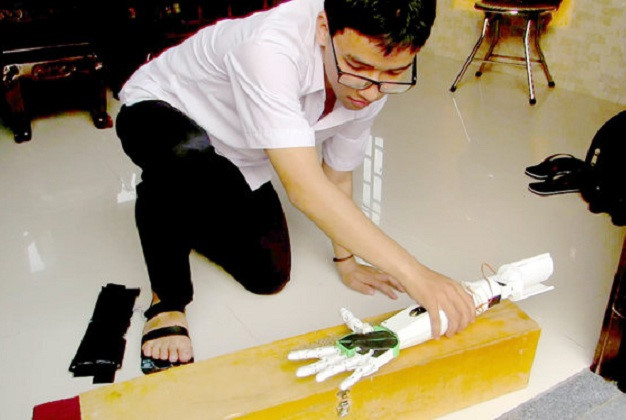
Pham Huy, a 12th grader in the central province of Quang Tri, has created a low-cost robotic arm for the disabled. His product won third prize at the Intel Int'l Science and Engineering Fair 2017.
 |
Pham Huy, a 12th grader in the central province of Quang Tri, has created a low-cost robotic arm for the disabled. His product won third prize at the Intel Int’l Science and Engineering Fair 2017. Huy has been voted among the top ten outstanding Vietnamese youngsters of 2017.
Pham Huy is a student in a high school for the gifted in the central province of Quang Tri.
Born in a province notorious for landmines, unexploded ordnance, accidents and birth defects, Pham Huy nurtured the thought of creating a robotic arm to help the disabled perform daily activities more easily.
When he was in eighth grade, he watched a TV programme about a robotic arm manufactured in the US which could be attached to the arm of disabled people. He started thinking about how to make a more affordable and helpful product.
According to Pham Huy, there are many disabled people who could be victims of landmines, traffic accidents or birth defects. Most of them do not have the tools to support activities in daily lives. They cannot afford high-cost robotic arms. That’s why he mulled over his own low-cost device that can be used to support basic movements.
Huy had to spend two years to learn about algorithms to implement his project.
The principle of this product is simple: it uses the movement of toes and feet to control fingers, hands and arms.
The special feature of the robotic arm is that it utilizes 3D printing technology to create parts of the cover with high accuracy.
Huy's teacher in Quang Tri High School, Le Cong Long told reporters: "Huy has a passion for scientific research. While guiding him, I find him good at information technology, 3D printing technology and graphic design. It can be said that Huy’s project is practical."
Huy and his teacher tested robotic arms on individuals with disabilities to gather data on where improvements were needed.
He continued focusing his study on programming and 3D design to achieve his dream of becoming a robot programmer and producing more products supporting people with disabilities.
(Source: VNA)





